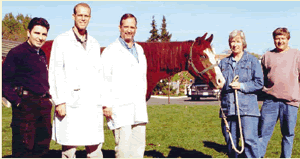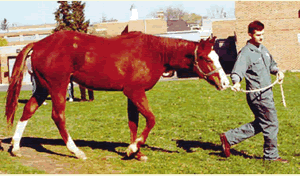|
|

Surgical treatment
available for wobblers
by Antonio M. Cruz,
Veterinary Teaching Hospital, University of Guelph
Wobbler syndrome encompasses a group of diseases characterized by gait
instability. One of these diseases comes under the name of cervical vertebral
stenotic myelopathy, producing spinal cord compression at the neck level.
This is a disease characterized by an abnormal gait in the front and/or
hind legs, usually worse in the hind. It is referred to as
“wobbler” syndrome as the horse may seem wobbly when walking
or exercising. The severity of the observed signs varies among horses.
Some horses may seem to have
a stiff neck, appear weak or “lazy”, stumble more than normal,
or give missteps. Others may be reluctant to rise or fall easily. These
horses suffer from “ataxia” — a loss
of the sense of where their feet are placed — and may appear “drunk”
as the horse lacks perception of where its limbs are.
The etiology of this condition has been linked to osteochondrosis and
to nutritional factors including mineral imbalances. The potential inherited
nature of this disease has been widely debated. To date, no single cause
of the condition has been identified but in growing
animals it is believed that a strong dietary component is involved in
this disease.
 |
Brad
and Debbie Waekens (right) brought Zippy, then a yearling, to the
OVC suffering from severe ataxia. A
team of veterinarians, Drs. Antonio Cruz, Scott Weese, and Dan Kenney
(left to right) and neurologist Dr. Smith-Maxie diagnosed Zippy.
|
 |
With
the help of Dr. James Robertson, of Ohio State University, surgery
was performed that involved fusing the affected vertebrae in the
young horse’s neck. Over a year later Zippy is steady and comfortable
and looks as if he will be able to pull his family in a carriage.
While the success of the surgical treatment is based on a number
of factors, across North America a reported improvement in 75 %
of the cases is encouraging.
|
Diagnosis
It is important to recognize the signs of wobbler syndrome and identify
an affected horse early to give your horse the best chance to heal. Since
the clinical condition known as “wobbler” encompasses spinal
cord compression as well as other conditions causing ataxia, the collection
and examination of the cerebrospinal fluid (CSF) is essential. Other differentials
include Equine Protozoal Myeloencephalitis (EPM), a neurological form
of rhinopneumonitis and traumatic injuries. The perception that the problem
is increasing in the horse population may actually be due to an increased
awareness, as well as improved expertise in applying more sophisticated
diagnostic methods.
To correctly diagnose your horse a veterinarian will perform a neurologic
examination and identify the location of the lesion (i.e. brain, spinal
cord). Further diagnostic tests will be required, including the radiography
(x-ray) of the cervical spine and performing a
contrast study of the spinal canal (myelogram) under general anesthesia.
This is currently only available in Ontario at the Ontario Veterinary
College (OVC). A myelogram involves the injection of a special contrast
media around the spinal cord immediately followed by
radiographs. The contrast media will highlight the roof and floor of the
spinal canal allowing a view of any significant narrowing. The development
of low-toxicity
contrast media has diminished the side effects and the rate of complication
associated with this procedure. A cerebrospinal fluid (CSF) sample will
be collected prior to
the myelogram. The CSF will be submitted to the university laboratory
for routine examination as well as to a Kentucky laboratory for EPM testing.
Treatment
A wobbler left untreated may deteriorate to the point of injuring itself
or others, especially when struggling to rise. In the short term, medical
treatment for subtly affected animals, along with stall rest, may provide
relief. In the long term, often the animal will relapse when allowed unrestricted
exercise or when placed in training.
Until now, most wobblers
were euthanized. However, horse owners have demanded a better approach
to treating these animals. This has resulted in a more widespread acceptance
of surgical treatment. These techniques are now being demonstrated successfully
at the Ontario Veterinary College (OVC), Large Animal
Clinic.
For more information on wobbler syndrome, visit the Disease Watch Index
at www.erc.on.ca
(519) 837-0061, Fax: (519) 767-1081
|

